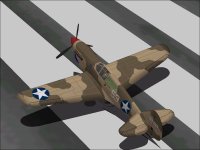Hawk 87W - Update
There hasn't been much activity on the Hawk 87W (P-40N) but there has been some.
The SCASM processing is now complete.
This means that further texture updates will be much simpler because the files are BMP format.
The animation changes are also complete.
One thing that has bothered me for a while is that the low speed handling of the P-40 seemed to be too good.
There appeared to be way too much control authority.
My task over the last couple days was to adjust the low speed control without compromising the generally excellent handling.
After creating spreadsheets to graph the control effect versus aerodynamic force (1/2 Rho V^2) and making adjustments,
I found that what I arrived at for new values was not significantly different from what is currently in place.
In other words, it appears to be pretty well tuned (or where I want it to be) now.
There was one area in which the values were different; My new values for Rudder Effect were a bit lower at low speed.
The question then becomes: Is the Rudder Effect too high or is the Propeller Torque Effect too low?
In any case, the Low Speed Rudder Effect is only noticeable if the Tail Wheel is made free castoring instead of steerable which means that in the actual flight model with a steerable Tail Wheel it is invisible.
The other minor change is to test a different texture pattern on the Spinner.
The later model P-40 especially when used by the RAF, RAAF, and RNZAF had a tendency to use two colours there.
The texture is a bit harder to apply than usual because it is Fore-Aft instead of Left-Right.
- Ivan.
There hasn't been much activity on the Hawk 87W (P-40N) but there has been some.
The SCASM processing is now complete.
This means that further texture updates will be much simpler because the files are BMP format.
The animation changes are also complete.
One thing that has bothered me for a while is that the low speed handling of the P-40 seemed to be too good.
There appeared to be way too much control authority.
My task over the last couple days was to adjust the low speed control without compromising the generally excellent handling.
After creating spreadsheets to graph the control effect versus aerodynamic force (1/2 Rho V^2) and making adjustments,
I found that what I arrived at for new values was not significantly different from what is currently in place.
In other words, it appears to be pretty well tuned (or where I want it to be) now.
There was one area in which the values were different; My new values for Rudder Effect were a bit lower at low speed.
The question then becomes: Is the Rudder Effect too high or is the Propeller Torque Effect too low?
In any case, the Low Speed Rudder Effect is only noticeable if the Tail Wheel is made free castoring instead of steerable which means that in the actual flight model with a steerable Tail Wheel it is invisible.
The other minor change is to test a different texture pattern on the Spinner.
The later model P-40 especially when used by the RAF, RAAF, and RNZAF had a tendency to use two colours there.
The texture is a bit harder to apply than usual because it is Fore-Aft instead of Left-Right.
- Ivan.












